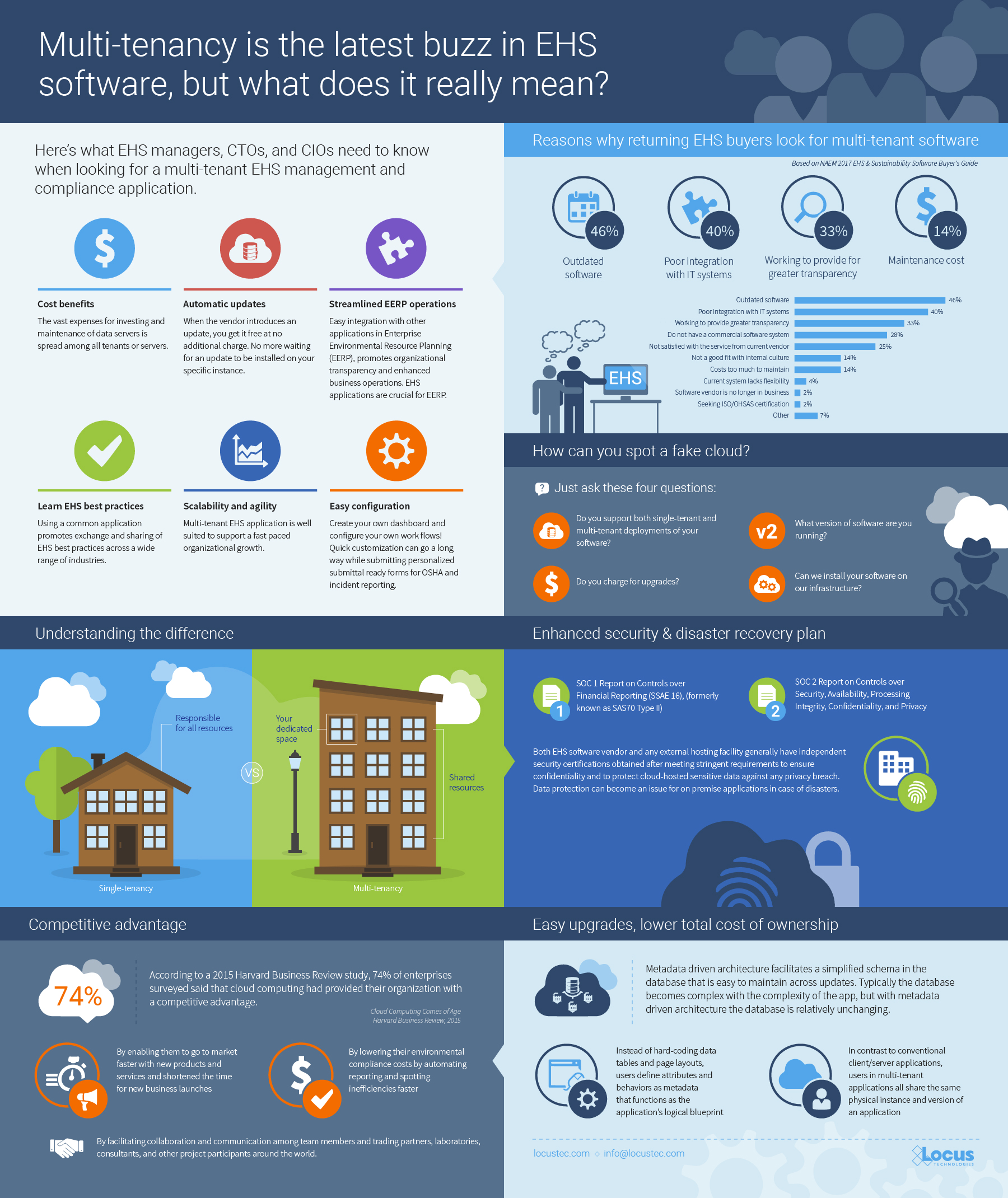There is a considerable degree of (intended) confusion in the EHS software space when it comes to multi-tenancy. Companies that are considering Software-as-a-Service (SaaS) hear all sorts of things from EHS software vendors hoping to tap into the momentum of cloud computing. Among the most common is that multi-tenancy is a “techie” thing that doesn’t need to be part of the conversation. Many go as far as saying “sure, we can do multi-tenant, single-tenant, whatever you need!”— anything to win the job.
Unfortunately, those vendors simply do not understand what they are talking about. Multi-tenancy is a major shift in computing and requires all new approach to software architecture and delivery model. It is transformational, and customers who intend to buy the next generation of EHS software should spend the time to understand differences.
Multi-tenancy is the core foundation of modern SaaS and shouldn’t be taken lightly, generalized, or massaged into something that suits a vendor’s self-serving interpretation of SaaS. Having experienced first-hand the true benefits of multi-tenant SaaS, I can’t conceptualize how SaaS would have delivered those benefits if it wasn’t multi-tenant. Can anyone imagine companies like Salesforce, NetSuite, Google, or Amazon offering a “single-tenant” solution side by side to their multi-tenant clouds? I will go as far as say that any company offering a single-tenant solution cannot be a serious contender in offering multi-tenant SaaS.
I would also add that single-tenant (hybrid) cloud applications are worse than on-premise installment. Why? Because they are fake clouds. In these instances, a customer is, in fact, outsourcing maintenance of their application to a vendor that is not equipped for that maintenance. No single vendor in the EHS software industry is large enough to undertake maintenance of the single-tenant infrastructure on behalf of their customers, regardless how inexpensive hardware may be.
There are many ways to take the functions of on-premise installed software model of the 1980s and package them as services. Some of these service delivery modes– such as ASP, single-tenant hosting, and hybrid clouds– merely relocate and reassign long-standing problems and potentially make them worse. In a single-tenant model, user customizations may infiltrate throughout the stack, in a way that makes it difficult to upgrade the performance of the stack. The true SaaS models confront and mitigate– or even eliminate– some of the most vexing elements of software installation and maintenance: configurability on the fly, software maintenance, and upgrades. It is “a tyranny of software upgrades” that kills the single-tenant model.
Let me offer a simple analogy to drive home the point as to why multi-tenancy matters: Tesla vs. Edison– War of Currents.
The War of Currents was a series of events surrounding the introduction of competing electric power transmission systems in the late 1880s and early 1890s that pitted companies against one another and involved a debate over cost and convenience of electricity generation and distribution systems, electrical safety, and a media/propaganda campaign, with the main players being the direct current (DC) based on the Thomas Edison Electric Light Company and the supporters of alternating current (AC) based on Nikola Tesla’s inventions backed by Westinghouse.
With electricity supplies in their infancy, much depended on choosing the right technology to power homes and businesses across the country. The Edison-led group argued for DC current that required a power generating station every few city blocks (single-tenant model), whereas the AC group advocated for a centralized generation with transmission lines that could move electricity great distances with minimal loss (multi-tenant model).
The lower cost of AC power distribution and fewer generating stations eventually prevailed. Multi-tenancy is equivalent of AC when it comes to cost, convenience, and network effect. You can read more about how this analogy relates to SaaS in the book by Nicholas Carr, “Big Switch,” a Wall Street Journal bestseller. It’s “the best read so far about the significance of the shift to cloud computing,” said Financial Times. The EHS software industry has been a laggard in adopting multi-tenancy.
Given these fundamental differences between different modes of delivering software as a service, it is clear that the future lies with the multi-tenant model.
Whether all customer data is put onto one database or onto multiple databases is of no consequence to the customer. For those arguing against it, it is like an assertion that companies “do not want to put all their money into the same bank account as their competitors,” when what those companies are doing is putting their money into different accounts at the same bank.
When customers of a financial institution share what does not need to be partitioned—for example, the transactional logic and the database maintenance tools, security, and physical infrastructure and insurance offered by a major financial institution—then they enjoy advantages of security, capacity, consistency, and reliability that would not be affordably deliverable in isolated parallel systems.
In enterprise cloud applications and cloud application platforms, multi-tenancy yields a compelling the combination of efficiency and capability without sacrificing flexibility or governance.
When a software provider seeks to blur the distinctions between one technology and another, there’s usually just one reason: because they are unable to offer the superior technology to their customers, and hope to persuade their customers that real differences are not relevant to their needs. Multi-tenant platforms for enterprise on-demand applications represent genuine opportunities for customer advantage. The reality of multi-tenant differentiation is acknowledged by authoritative industry analysts such as Gartner, whose March 2007 announcement1 of its Outsourcing Summit that month included this definition of Software as a Service:
“Hosted software based on a single set of common code and data definitions that are consumed in a one-to-many model.”
In other words, hosting models that do not offer the leverage of multi-tenancy don’t belong in the same discussion as the value proposition implied by the term, “SaaS”. Multi-tenancy is a difference that makes a difference.
—
References
1Gartner Inc., “SaaS will have significant impact on IT services and outsourcing providers,” Tekrati, 7 March 2007

